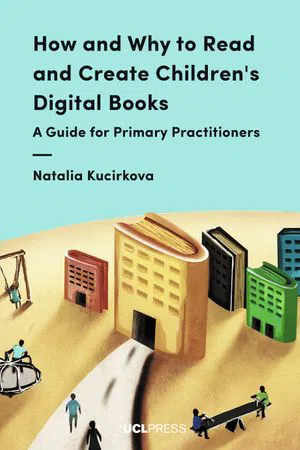
- English
- PDF
- Available on iOS & Android
About this book
How and Why to Read and Create Children's Digital Books outlines effective ways of using digital books in early years and primary classrooms, and specifies the educational potential of using digital books and apps in physical spaces and virtual communities. With a particular focus on apps and personalised reading, Natalia Kucirkova combines theory and practice to argue that personalised reading is only truly personalised when it is created or co-created by reading communities. Divided into two parts, Part I suggests criteria to evaluate the educational quality of digital books and practical strategies for their use in the classroom. Specific attention is paid to the ways in which digital books can support individual children's strengths and difficulties, digital literacies, language and communication skills. Part II explores digital books created by children, their caregivers, teachers and librarians, and Kucirkova also offers insights into how smart toys, tangibles and augmented/virtual reality tools can enrich children's reading for pleasure.
Frequently asked questions
- Essential is ideal for learners and professionals who enjoy exploring a wide range of subjects. Access the Essential Library with 800,000+ trusted titles and best-sellers across business, personal growth, and the humanities. Includes unlimited reading time and Standard Read Aloud voice.
- Complete: Perfect for advanced learners and researchers needing full, unrestricted access. Unlock 1.4M+ books across hundreds of subjects, including academic and specialized titles. The Complete Plan also includes advanced features like Premium Read Aloud and Research Assistant.
Please note we cannot support devices running on iOS 13 and Android 7 or earlier. Learn more about using the app.
Information
Table of contents
- Contents
- List of figures
- Preface
- Acknowledgements
- 1 Introduction
- 2 Summary of research on children’s digital books
- 3 Children’s digital books: where to find them and how to evaluate them
- 4 Using digital books to support children’s language and literacies
- 5 Using digital books to support individual children
- 6 Children as authors of digital books
- 7 Teachers as authors of children’s digital books
- 8 Parents as authors of children’s digital books
- 9 Digital libraries and library management systems
- 10 Innovative approaches to support personalised multimedia story-making
- Conclusion
- References
- Index